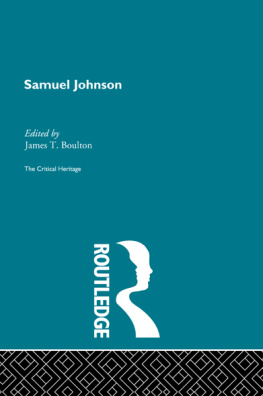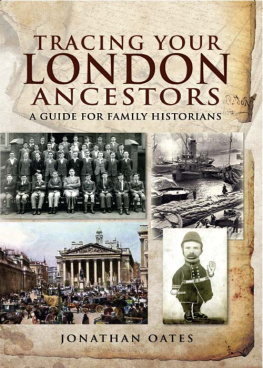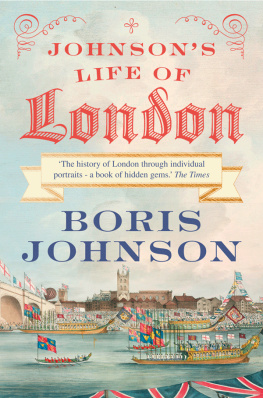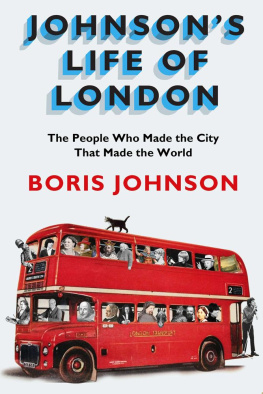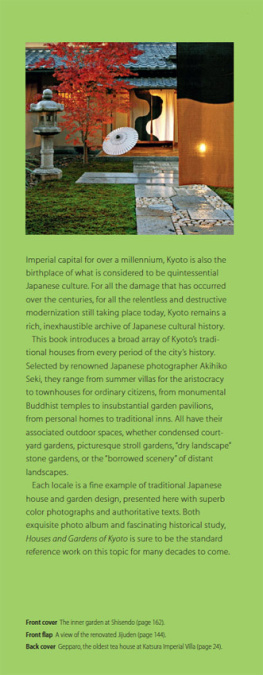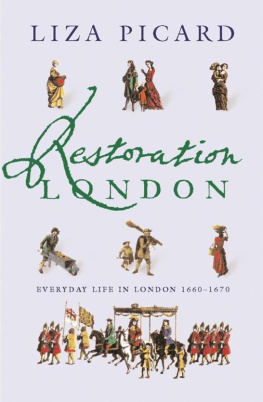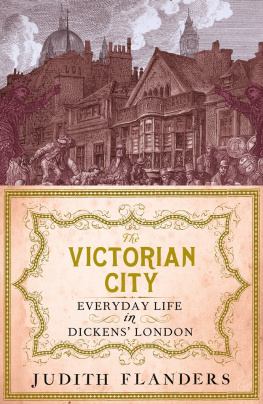
The author and publisher have provided this e-book to you for your personal use only. You may not make this e-book publicly available in any way. Copyright infringement is against the law. If you believe the copy of this e-book you are reading infringes on the authors copyright, please notify the publisher at: us.macmillanusa.com/piracy.
Contents
When a man is tired of London he is tired of life; for there is in London all that life can afford.
Samuel Johnson
Preface
Welcome gentle reader, to the select company of those who read prefaces, whether before as I hope or after as I usually do reading the book. This is where I can explain why I wrote the book at all, and how I set about it.
First of all, I should say that I am not a properly trained historian. I am a lawyer by trade, and an inquisitive practical woman by character. I have always enjoyed history, but I have found it difficult, from most history books, to imagine real people going about their daily lives, worrying more about the price of bread than the habits of the nobility. The trend of history writing is increasingly turning towards the man and woman in the street. But even now there is a tendency, it seems to me, to focus on the few rich and the comfortably off, to the exclusion of the majority of people, who were poor. One reason for this is the heritage of buildings and works of art which we still enjoy, and which we identify as typical of the eighteenth century. They have survived because they were built or commissioned or acquired by the rich. The poor were hard put to it to get along at all. They had no money for non-essentials, and no leisure to write diaries or novels. Nothing remains of their lives.
So how could the blank canvas be filled in, between the haves and the have-nots? This book tries to answer that question.
First, I had to choose a period, rather than try to cover the whole century. There were no obvious starting and ending posts, as there had been for my Restoration London He thought he could finish it in three years, but it was not published until 1755, after many crises. It made his name, although not his fortune; the booksellers got most of the proceeds. In 1770 Johnson was still going strong. He died in London in 1784, at the age of 73. For my purposes, however, his long residence in his much-loved London nearly fifty years was too long a period for the kind of detailed account that I wanted to record, so I decided to end the period at 1770, when the east coast of America was still British, the gin-drinking craze was mostly over, and London had taken the shape it would largely retain until the Victorians gave it another mighty shake. The period is arbitrarily chosen, I agree.
Now for the evidence. So far as contemporary witnesses were concerned, perhaps the most impartial were foreign visitors, taking in London as English travellers took in Florence and busily writing up their journals as they went, for publication in their native languages. They had to make their accounts interesting to the readers back home, to ensure that they sold, but they could not afford to diverge too far from the truth for fear of ridicule. They needed to have some individual angle, but still appeal to the general reader. In the period I have chosen, there were several tourists with observant eyes and ready pens. I trusted Monsieur Pierre Jean Grosley most, because he was a lawyer. He was here in 1765, when he was 47 years old. The English translation of his book A Tour to London was published in London in 1772. M. Grosley wrote I relate things as I have seen them. His translator explains that he corrected anything that M. Grosley had got wrong. So his book is doubly reliable. He cast a professional eye over the English legal system. He also described going to the theatre, and there is no reason to doubt his account just because it is very funny (see Chapter 22).
A 32-year-old Swedish botanist Per Kalm paused in England on his way to America, in 1748. He saw a different side of London. He took an accurate note of anything growing. He was also intrigued by the habits of Londoners which he could see as he walked about, such as the different methods of not tracking street dirt into the house, and the way coal was delivered. His book was translated into English and published here in 1892.
Then there was Casanova. This is a name that may conjure up all kinds of licentiousness. Indeed I had to go through various hoops before I was allowed to read his memoirs in the Bodleian Library, in case, at my advanced age, they might corrupt me. But all I wanted, and more or less all I found, was what he made of London when he was here in 1763, running an experienced eye over the social and sexual mores of Londoners.
Francis Places autobiography, in his beautiful copper-plate script, can be read in the British Library. He was born in 1771, so his childhood recollections are after our period, but I have used them when the details he recorded are unlikely to have changed.
Since London was such a draw, there was a surge in the production of maps and guidebooks, from the sixpenny pamphlet for the countryman, to the massive Plan of the Cities of London and Westminster and the Borough of Southwark published in 24 sheets, together measuring six and a half feet by thirteen, produced by John Rocque in 1747. There were written histories and descriptions covering every parish in London, including a 1754 update by careful hands anonymous of John Stows Survey of London first published in 1598, and a New and Accurate History and Survey of London, Westminster and Southwark by John Entick published in 1766.
There were publications pleading causes, textbooks imparting information, manuals advising on cooking and home remedies with a bit of DIY thrown in, and periodicals looking to increase their circulation figures. Jonas Hanway is usually thought of, inaccurately, as the first person to use an umbrella in London. He was much more than that a passionate pleader for young people and a skilful and prolific media man. There was a group of writers on medical matters whose teaching was the received wisdom of the time. They were not necessarily medically qualified. This was an era when any intelligent man would have a go at diagnosis and treatment. Samuel Johnson prided himself on his medical knowledge; so did John Wesley, who wrote a book about it and set up several clinics for people wishing to try the therapeutic effects of electricity. The Gentlemans Magazine, which in the best Fleet Street manner boasted of its circulation figures month by month, was my mainstay for the kind of news item that intrigued people then not necessarily of world-shaking importance, just interesting, such as the amount of money a lucky bridegroom was marrying. It was aimed at a middle-class readership. (Middle class had not yet been coined the correct phrase was the middling sort, which perhaps carries less baggage.)
There was a wide spread of newspapers. Here I have to admit defeat in my pursuit of contemporary evidence. In their paper form, eighteenth-century newspapers are now very fragile, and both the British Library and the Bodleian make them available only on film, which is exceedingly difficult to decipher. There are many issues of many newspapers that I have not read. Fortunately, the gaps are sometimes filled by extracts in the works of earlier historians with better sight or more opportunity to see the originals.
And, of course, there were Samuel Johnson and James Boswell. Johnsons brutally bad manners in conversation, which Boswell displayed like a lion-tamer provoking his charge to roar, grew on him as he got older and more famous. Boswells Life of Samuel Johnson is useful for a picture of literary London, as long as Johnsons worst conversational squibs are recognised for what they were, the triumph of bad manners over accuracy. Boswells own Journal is possibly more readable: an accurate self-portrait of an unlikeable young man.
Next page

